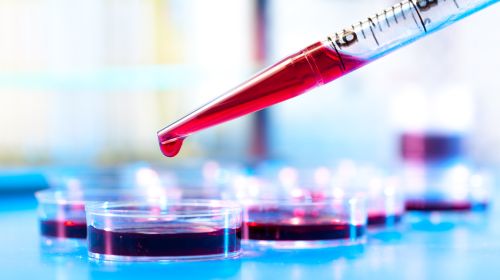Immunoglobulins play a central role in the immune system. They are programmed to recognize and fight off very specific pathogens. The concentration of immunoglobulins in the blood gives an indication of certain diseases and how well the immune system is working.
- With their arms, immunoglobulins can identify and eliminate pathogens.
- © iStock.com/Svisio
Immunoglobulins are also called antibodies and are part of our immune system. These are proteins whose function is to track down various pathogens and substances that penetrate the body. The immunoglobulins can recognize very different chemical structures foreign to the body: bacteria, viruses, toxins or even pollen and other allergens.
The immunoglobulins are divided into different classes – depending on where in the body and at what stage of contact they work. Four classes of immunoglobulins are important in humans:
How immunoglobulins work
The Immunoglobulins are ypsilon-shaped proteins. Because of their shape based on the Greek letter gamma, they are also called gamma globulins. They are made up of special white blood cells, the B lymphocytes. Each immunoglobulin is trained for very specific pathogens and fits like a key in just a lock. It can recognize the specific chemical structure in each case and dock onto it with its Y-arms. The third end of the Y connects to the body's own defense cells, which ultimately destroy the foreign substances.
The majority of the antibodies are initially assembled during the "first contact", i.e. an initial infection with bacteria or viruses. Once the infection is over, the body retains the immunoglobulins against the respective pathogen, making it immune to it.
This principle is used in many protective vaccinations. Contact with pathogenic germs (viruses or bacteria) is simulated: killed or weakened pathogens or only parts of them are injected. The immune system is stimulated to produce the appropriate immunoglobulins. In the event of a later, real infection, the body already has the appropriate antibodies ready and can immediately send them into the field for defense.
However, antibodies can also be incorrectly programmed and directed against the body's own substances. This leads to inflammation; the body's own tissue is damaged and destroyed. Typical examples of such autoimmune diseases are rheumatism, type 1 diabetes, Crohn's disease or multiple sclerosis.
Immunotherapy: When Antibodies Heal
Antibodies can also be produced artificially and used to treat diseases. Such immune or antibody therapy is now used for certain types of cancer, autoimmune diseases and chronic inflammatory bowel diseases. With specific immunotherapy or desensitization of allergies, attempts are made to train the immune system so that it is less sensitive to certain allergens.
When to determine immunoglobulin levels
Immunoglobulins can be found in the blood, in the lymph and to some extent in saliva, tear fluid, the mucus from the stomach and intestines and other secretions. Laboratory diagnostics determine the Ig values mainly in the blood.
The blood values for immunoglobulins are not standard parameters in diagnosis. However, their concentration in the blood can provide information about how well the immune system is set up and whether someone is already immunized against certain diseases.
In detail, the doctor can have the immunoglobulin values determined at / for
increased Tendency to infections and infections
suspicion of Autoimmune diseases
Diagnosing infectious diseases like HIV, syphilis, chlamydia, and others
Checking whether a Contact with a pathogen has taken place
Checking immunity against certain pathogens, for example whether a vaccination was effective
Diagnosis of Allergies
control conventional therapy or antibody therapy and the course of an infectious disease or autoimmune disease
When diagnosing certain infectious diseases (for example HIV), the search is often only made for the specific antibodies for the respective disease. In pregnant women, for example, the blood can be examined specifically for antibodies against toxoplasmosis and rubella (if there is no rubella vaccination).
-

Fever, pain, shortness of breath: Search specifically for symptoms and their possible triggers
to the symptom check
Complete immune status no health insurance benefits
Some laboratories and medical practices also offer checking of all immunoglobulins in a complete immune status or basic immune check – often in connection with a complete blood count. As an IgeL service, this laboratory test must be paid for by yourself.
Such an immune status can provide indications of immune deficiencies and immunodeficiencies. In symptom-free people, however, there are at most incidental findings for very few diseases.
The immune status is therefore not recommended by experts as a routine or preventive check-up. It is different with genetically predisposed people: Here the statutory health insurance companies assume the costs for determining the immunoglobulin values for certain indications.
Immunoglobulin A (IgA)
Immunoglobulin A (IgA) is responsible for the defense against pathogens at the entry points of the body, for example on the mucous membranes in the nose and throat and in the digestive system. Immunoglobulin A makes up around ten to 15 percent of all antibodies and is found in the gastrointestinal tract, in the genital area or in the tear fluid. The IgA antibodies are transferred to the newborn through the breast milk and thus protect the infant from infections through the mucous membranes.
If a patient suffers from infections frequently, the doctor can have the immunoglobulin A value determined to be on the safe side. Autoimmune diseases can also be diagnosed with this immunoglobulin value.
Normal range for IgA value
If the immunoglobulin A value is between 0.7 and 4.0 g / l (grams per liter), the value is in the normal range.
Causes of an excessively high IgA level
If the immunoglobulin A value rises, this can be an indication of liver disease (cirrhosis of the liver), excessive alcohol consumption or an autoimmune disease. The immunoglobulin A value can also be increased in acute infections.
Causes for an IgA level that is too low
The selective IgA deficiency (also IgA antibody deficiency syndrome) is the most common immune deficiency. The IgA values are below the normal range. This hereditary disease is usually associated with increased respiratory infections. The immunoglobulin A value can also be too low in the case of kidney disease.
Immunoglobulin G (IgG)
The largest group of antibodies are the immunoglobulins G (IgG). They protect the body against viruses and bacteria. IgG make up about 60 to 80 percent of antibodies. They are formed quite late in an infection – but they are extremely important for the "memory" of the immune system. Because they are used later when there is renewed contact with pathogens (bacteria, viruses). They are also important in the case of chronic infections, for example hepatitis, and chronic inflammatory processes.
An embryo is supplied with immunoglobulin G via the placenta during pregnancy. However, this "nest protection" only lasts three months. The newborn's immune system then has to produce antibodies by itself.
Normal values for IgG
The immunoglobulin G value is between 7 and 16 g / l within the normal range.
Causes of an excessively high IgG level
The increased IgG value is an indicator especially for acute or chronic infections. But liver diseases (liver cirrhosis, hepatitis) also cause the level to rise. Patients who suffer from multiple sclerosis also often have an elevated immunoglobulin G value.
Causes of low IgG levels
If the patient has kidney disease, this can be indicated by the low immunoglobulin G value. In the case of leukemia, too, an IgG level that is too low can often be determined.
Immunoglobulin E (IgE)
Antibodies of the immunoglobulin E (IgE) class protect against intestinal bacteria and parasites. In addition, IgE is responsible for allergic reactions. It represents the smallest part of the antibodies with about 0.1 percent. Immunoglobulin E plays a major role in fighting parasites. The blood value is also measured in connection with allergies.
Normal range for IgE levels
If the immunoglobulin E values are between 12 µg / l and 240 µg / l, they are in the normal range.
Causes of an excessively high IgE level
If an immunoglobulin value is measured above the normal range, this can indicate an allergy such as hay fever, asthma or neurodermatitis.
Causes of an IgE level that is too low
If the immunoglobulin E value in the laboratory test is below the normal value, this is an indication that the patient is not allergic or parasitic. However, values that are too low can indicate kidney disease.
Immunoglobulin M
Immunoglobulin M (IgM) represents the fourth group of antibodies. They are the first to be formed when there is contact with pathogens or other foreign substances and represent the first effective line of defense against microorganisms in the organism. After the acute phase, the IgM concentration drops again, then the IgG antibodies take over the further work. An acute infection can be determined on the basis of the immunoglobin M value.
Normal values for IgM
The immunoglobulin M value is between 0.4 and 2.4 grams per liter (g / l) in the normal range.
Causes of an excessively high IgM level
If the immunoglobulin M value rises above the normal range, a leukemia disease or an acute infection may be the cause. Liver diseases and autoimmune diseases also increase IgM levels.
Causes of an IgM level that is too low
Low immunoglobulin M values can be an indication of kidney disease.


